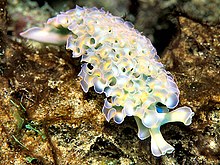Elysia crispata
| Lettuce sea slug | |
|---|---|
 |
|
| A live individual of the lettuce sea slug in situ, head end towards the lower right | |
| Scientific classification | |
| Kingdom: | Animalia |
| Phylum: | Mollusca |
| Class: | Gastropoda |
| (unranked): |
clade Heterobranchia clade Euthyneura |
| Superfamily: | Plakobranchoidea |
| Family: | Plakobranchidae |
| Genus: | Elysia |
| Species: | E. crispata |
| Binomial name | |
|
Elysia crispata (Mörch, 1863) |
|
| Synonyms | |
|
|
clade Euthyneura
clade Panpulmonata
clade Sacoglossa
clade Plakobranchacea
Elysia crispata, common name the lettuce sea slug, is a large and colorful species of sea slug, a marine gastropod mollusk.
The lettuce slug resembles a nudibranch, but it is not closely related to that clade of gastropods; it is classified as a sacoglossan.
This species is called the lettuce slug because it is often green in color, and it always has a very frilly edge to its parapodia. This makes the slug resemble the curly kinds of lettuce, such as the lollo rosso variety. The maximum length of this species is about 5 cm and 3 cm in width.
The lettuce slug is extremely variable in color: it can also be blue, or very pale with red lines or yellow lines.
This species lives in the tropical parts of the western Atlantic, and the Caribbean faunal zone. They are found in more coastal and tropical reef areas where the water is shallow and clear.
E. crispata can be either heterotrophic or autotrophic throughout their lifespan. As juveniles, food is consumed and digested quickly, with little chloroplast retention. Upon reaching maturity, kleptoplasty becomes an important energy source. The primary food source of E. crispata is relatively unknown, although some individuals have been known to consume a diversity of algal species such as Vaucheria litorea, Caulerpa verticillata, Caulerpa racemosa, Halimeda discoidea, Halimeda incrassate, Halimeda monile, and Penicillus capitatus; C. verticillata being suitable for a limited amount of time. This diversity in food sources is a different characteristic compared to other Sacoglossan’s who are specialized for one species of algae, and gives E. crispata a survival advantage when food is depleted or sparse. Chloroplasts within their parapodia (fleshy dorsal protrusions) continue to produce energy products through carbon fixation throughout their life and have been found to function efficiently for a little over a month.
...
Wikipedia
